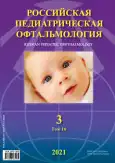Treatment outcomes of central retinopathy of prematurity with localization in the Moscow regional perinatal center
- Authors: Panova A.Y.1,2, Petrova A.S.2, Trusova S.A.2, Shevernaya O.A.2
-
Affiliations:
- Helmholtz National Medical Research Center of Eye Diseases
- Moscow Regional Perinatal Center
- Issue: Vol 16, No 3 (2021)
- Pages: 19-26
- Section: Original study article
- URL: https://journal-vniispk.ru/1993-1859/article/view/70957
- DOI: https://doi.org/10.17816/rpoj70957
- ID: 70957
Cite item
Abstract
BACKGROUND: Ranibizumab is widely used in retinopathy of prematurity. Therefore, it is necessary to evaluate the effectiveness, the risk of complications, and recurrence of the disease by antiangiogenic therapy.
AIM: To demonstrate the experience of using anti-VEGF drugs in the Moscow Regional Perinatal Center and the effectiveness of different approaches to retinopathy of prematurity (ROP) treatment in the central retinal zone.
MATERIAL AND METHODS: The case histories of 17 deeply premature infants with threshold ROP stages and localization in the posterior pole were retrospectively analyzed. Children were treated with intravitreal VEGF inhibitor (total 9 children), 5 children underwent laser coagulation of the retina, and 3 children received combined treatment (laser and intravitreal administration of a VEGF inhibitor).
RESULTS: The average age of development of threshold stages was 35.2 weeks (range: 30.5–39 weeks) in our study. The frequency of promising outcomes after using anti-VEGF drugs alone or in conjunction with peripheral laser treatment was 100%. In comparison, the only laser treatment generated a promising result in 70% of the eyes. However, ROP relapses after anti-VEGF therapy developed at 37, 43, 44,5 weeks. In addition, 1 out of 9 children developed a recurrence of ROP and required laser treatment 7 weeks after using anti-VEGF.
CONCLUSION: The use of anti-VEGF therapy is an effective method for the treatment of ROP of the posterior pole. However, there is the ambiguity of the available recommendations on the further management of children. Therefore, it is necessary to monitor the children who have received antiangiogenic therapy for as long as possible.
Full Text
##article.viewOnOriginalSite##About the authors
A. Y. Panova
Helmholtz National Medical Research Center of Eye Diseases; Moscow Regional Perinatal Center
Email: annie_panova18@mail.ru
ORCID iD: 0000-0003-2103-1570
SPIN-code: 9930-4813
MD, PhD
Russian Federation, Balashikha; MoscowA. S. Petrova
Moscow Regional Perinatal Center
Email: as.petrova@icloud.com
ORCID iD: 0000-0002-8020-2598
MD, PhD
Russian Federation, BalashihaS. A. Trusova
Moscow Regional Perinatal Center
Email: svetlana28122@yandex.ru
ORCID iD: 0000-0001-6582-9571
neonatologist
Russian Federation, BalashihaO. A. Shevernaya
Moscow Regional Perinatal Center
Author for correspondence.
Email: shevernaya.olga@mail.ru
ORCID iD: 0000-0002-3948-0270
ophthalmologist
Russian Federation, BalashihaReferences
- Neroev VV, Katargina LA, Buyanovskaya SV, et al. Retinopatiya nedonoshennykh. Moscow: IKAR; 2020. (In Russ).
- Bradley J, Ju M, Robinson GS. Combination therapy for the treatment of ocular neovascularization. Angiogenesis. 2007;10(2):141–148. doi: 10.1007/s10456-007-9069-x
- Stahl A, Lepore D, Fielder A, et al. Ranibizumab versus laser therapy for the treatment of very low birthweight infants with retinopathy of prematurity (RAINBOW): an open-label randomised controlled trial. The Lancet. 2019;394(10208):1551–1559. doi: 10.1016/s0140-6736(19)31344-3
- Ahn YJ, Hong KE, Yum HR, et al. Characteristic clinical features associated with aggressive posterior retinopathy of prematurity. Eye (Lond). 2017;31(6):924–930. doi: 10.1038/eye.2017.18
- Ekinci DY, Celik K. Comparison of the Efficacy Between Intravitreal Aflibercept and Laser Photocoagulation in the Treatment of Retinopathy of Prematurity. J Pediatr Ophthalmol Strabismus. 2020;57(1):54–60. doi: 10.3928/01913913-20191104-01
- Bellsmith KN, Brown J, Kim SJ, et al. Aggressive Posterior Retinopathy of Prematurity: Clinical and Quantitative Imaging Features in a Large North American Cohort. Ophthalmology. 2020;127(8):1105–1112. doi: 10.1016/j.ophtha.2020.01.052
- Katargina LA, Demchenko EN, Kogoleva LV. Clinical Course and Results of Anti-VEGF Therapy of Retinopathy of Prematurity. Ophthalmology. 2021;18(1):136–142. (In Russ). doi: 10.18008/1816-5095-2021-1-136-142
- Mintz-Hittner HA, Kennedy KA, Chuang AZ, Group B-RC. Efficacy of intravitreal bevacizumab for stage 3+ retinopathy of prematurity. N Engl J Med. 2011;364(7):603–615. doi: 10.1056/NEJMoa1007374
- Mintz-Hittner HA, Geloneck MM, Chuang AZ. Clinical Management of Recurrent Retinopathy of Prematurity after Intravitreal Bevacizumab Monotherapy. Ophthalmology. 2016;123(9):1845–1855. doi: 10.1016/j.ophtha.2016.04.028
- Martinez-Castellanos MA, Gonzalez HLA, Romo-Aguas JC, Gonzalez-Gonzalez LA. A proposal of an algorithm for the diagnosis and treatment of recurrence or treatment failure of retinopathy of prematurity after anti-VEGF therapy based on a large case series. Graefes Arch Clin Exp Ophthalmol. 2020;258(4):767–772. doi: 10.1007/s00417-020-04605-y
- Wood EH, Rao P, Moysidis SN, et al. Fellow Eye Anti-VEGF ‘Crunch’ Effect in Retinopathy of Prematurity. Ophthalmic Surg Lasers Imaging Retina. 2018;49(9):e102–e104. doi: 10.3928/23258160-20180907-16
- Honda S, Hirabayashi H, Tsukahara Y, Negi A. Acute contraction of the proliferative membrane after an intravitreal injection of bevacizumab for advanced retinopathy of prematurity. Graefes Arch Clin Exp Ophthalmol. 2008;246(7):1061–1063. doi: 10.1007/s00417-008-0786-7
- Wutthiworawong B, Thitiratsanont U, Saovaprut C, et al. Combine intravitreal bevacizumab injection with laser treatment for aggressive posterior retinopathy of prematurity (AP-ROP). J Med Assoc Thai. 2011;94 Suppl 3:S15–21.
- Chung EJ, Kim JH, Ahn HS, Koh HJ. Combination of laser photocoagulation and intravitreal bevacizumab (Avastin) for aggressive zone I retinopathy of prematurity. Graefes Arch Clin Exp Ophthalmol. 2007;245(11):1727–1730. doi: 10.1007/s00417-007-0661-y
- Altinsoy HI, Mutlu FM, Gungor R, Sarici SU. Combination of Laser Photocoagulation and Intravitreal Bevacizumab in Aggressive Posterior Retinopathy of Prematurity. Ophthalmic Surg Lasers Imaging. 2010:1–5. doi: 10.3928/15428877-20100215-03
- Hu J, Blair MP, Shapiro MJ, et al. Reactivation of retinopathy of prematurity after bevacizumab injection. Arch Ophthalmol. 2012;130(8):1000–1006. doi: 10.1001/archophthalmol.2012.592
- Gunay M, Sukgen EA, Celik G, Kocluk Y. Comparison of Bevacizumab, Ranibizumab, and Laser Photocoagulation in the Treatment of Retinopathy of Prematurity in Turkey. Curr Eye Res. 2017;42(3):462–469. doi: 10.1080/02713683.2016.1196709
Supplementary files






